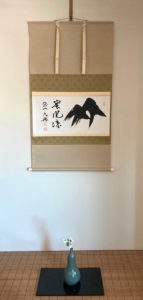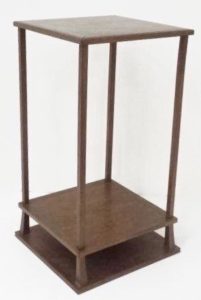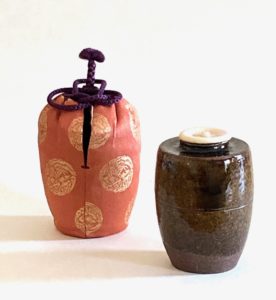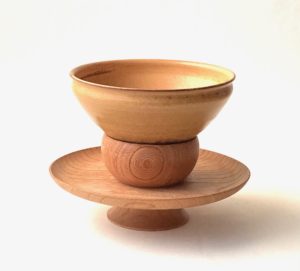Tea in June

Cha-dō-gu, 茶道具, Tea-way-tools, used in a presentation for a ki-nin, 貴人, noble-person, should not be overly showy, as they will take away from the dignified procedure for the honored guest. The cha-wan, 茶碗, tea-bowl, is most often in the form of Ten-moku, 天目, Heaven-eye, as the original Chinese Tenmoku teabowls were in that form, and were accompanied by a dai, 台, support. The chawan should be new, and is given to the guest after the presentation. Almost everything presented to the kinin is elevated above the floor level.


When hanging a scroll in the tokonoma, the exact center of the hon-shi, 本紙, main-paper, should be located in the center of the back wall of the tokonoma. In a tokonoma that has a mu-sō-kugi, 無双釘, no-pair-nail, hook, it is also in the exact center of the back wall of the tokonoma. The hook can be flush with the wall or pulled out to hang a flower container. The word is likened to a flower, which is especially true in Buddhism. When the Buddha transferred leadership over to his successor, it was enacted when Buddha handed a flower to Ma-ha-ka-sha-pa, 摩訶迦叶, Chafe-scold-(sound)-answer. Musōkugi may evoke the concept of the mu-sō-mon, 無相門, no-form-gate, the middle opening of three openings of a Buddhist temple gate.

Other meanings of take, 武, war, include the art of war, martial arts, military arts, the sword, valor bravery, military officer, etc. The word ‘art’ is not in everyone’s vocabulary. The same can be said of the ‘theater’ of war. The presence of the word take meaning bamboo, is to dispel the thought of take meaning war. During the campaign against the Hō-jō, 北条, North-branch, Rikyū turned three pieces of bamboo that were meant to make bamboo blades to commit suicide, take-mitsu, 竹光, bamboo-light, into three flower containers, take-mitsu, 竹三, three-bamboo.

The vase was made by American potters in the style of Ming China. It is stoneware, not porcelain, and not Chinese. Should it be placed on a shin usu-ita, 真薄板, true thin-board, ya-hazu ita, 矢筈板, arrow-nock board, in the center as a ‘Chinese’ vessel would be, or on a lacquered hamaguri-ba, 蛤端, clam-edge, board placed on the left side of the tokonoma?
The flower pictured at the beginning of this article is dogwood, hana-mizu-ki, 花水木, flower-water-tree, flowering dogwood (Cornus florida). Dog-wood is thought to be derived from dag-wood, skewer-wood.
Another type of dogwood is kousa that in Japanese is called, yama-bō-shi, 山法師, mountain-law-master, kousa dogwood (Cornus kousa); Japanese flowering dogwood. The flower resembles a hat worn by Buddhist monks.

A metal container for holding incense may be used with the furo and the ro, the same is true of incense containers made of seashell. Rikyū believed that metal should be substituted with some other material, as metal can be made into cash money. Metal can also be formed into an object that manifests a spiritual and peaceful purpose. Swords into plowshares. The rim of many Tenmoku teabowls is covered with a metal, silver, which in actuality touches the lips.


The size of the kama is appropriate for the fu-ro, 風炉, wind-hearth. Because the kantsuki are placed rather high on the body, the kama could be hung by a chain or bamboo pole over the ro, 炉, the sunken hearth: tsuri-gama, 釣釜, suspend-kettle. The surface of the kama appears to be darkened and timeworn, but it was intentionally created this way. One of the desired aspects of metal, is that it can often be highly polished to a mirror finish. Chanoyu has the custom of admiring that which is gives the appearance of age, even great age, and that it has been used. Curiously, many ordinary Japanese people don’t like old things, and want the new. But, not everything. The lid of this kama is bronze with an almost mirror finish, and elegant, sleek appearance, which is in high contrast with the timeworn, poignant look of the kettle. This contrast is a good example of wabi, 侘.

This portable ceramic hearth is classified as a do-bu-ro,土風炉, earth-wind-hearth, by Yamamoto Sōun. It has a black lacquered finish, and so is a shin–nuri do-bu-ro, 真塗土風炉, true-lacquer earth-wind-hearth. The form is a mayu bu-ro, 眉風炉, eyebrow wind-hearth, with an ovoid hi-mado, 火窓, fire-window, with three short round ashi, 足, feet.



The ‘kuwa ko-joku’, 桑小卓, mulberry small-stand, was created by of Sen Sen-sō, 千仙叟, Thousand Hermit-venerable gentleman, (1622-1697), IV Iemoto, Urasenke. The original stand was an adaptation of the ya-byō-bu, 矢屏風, arrow-wall-wind, a stand for arrows.
The display stand called a joku, 卓, differs from a tana, 棚, as the joku is a display stand borrowed from another purpose and use, whereas a tana is created for a specific purpose. Exceptions exist.


According to Urasenke tradition, when presenting Chanoyu to a ki-nin, 貴人, noble-person, the preferred usu-ki, 薄器, thin[tea]-container, is a Rikyū-gata chū-natsume, 利休形中棗, Rikyū-style middle-jujube. Again, this is to use utensils that show modesty and restraint, rather than with colorful, bright glazes and gold – ha-de, 派手, faction-hand, showy, flamboyant. A well-made Rikyū-gata chū-natsume with a black, mirror-like finish is a profoundly beautiful work of art that deeply touches the heart of people dedicated to Chanoyu. Always look with ‘new’ eyes, and truly see.

In Chanoyu, o-ka-shi, お菓子, hon.-sweet-of, and other foods are offered on a takatsuki to a person acting as a kinin. Sheets of folded paper are used on the stand to serve the sweets, which are in abundance, so that the remainder may be wrapped up and taken away by the guest.



Cha-shaku, 茶杓, tea-scoop; aged take, 竹, bamboo, with naka-bushi, 中節, middle-node, named ‘Un-gyō’, 吽形, Hm (growl)-shape, by Walter Hahn, Pleasantville, New York.
The name is derived from the Ni-ō, 仁王, Benevolent-king, guardians of the entrances to Buddhist temples, who are formally called Kon-gō Riki–shi, 金剛力士, Gold-strength Power-man. The guardian king with his mouth closed is called Ungyō, the king with his mouth open is called A-gyō, 阿形, Ah-shape. They are manifestations of receptive, In, and penetrative, Yō. A chashaku is both In and Yō depending on its use.
Ken-saki, 剣先, sword-before, blade point. The chashaku is not a weapon, however, certain Buddhist deities carry swords, Mon-ju Bo-satsu, 文殊菩薩, Literate-especially Sacred tree-buddha, wisdom of the Buddha, and Fu-dō Myō-ō, 不動明王, Not-move Bright-king.

The triple horseshoe futaoki poses some questions for many, what is the front and which end is up. The shō-men, 正面, correct-face, is one horseshoe. As a thing, a shoe worn by a horse has the round end at the front, so that the round part is the top as an object. When used as a futaoki it is turned over so that the two blunt ends of each shoe are upright, as shown in the above picture. Round is receptive, In, squared is penetrative, Yō.
In the west, a horseshoe is often nailed to a wall with the round end down for good luck, so that the ‘scoop’ can hold fortune in it. There are other opinions on which end is up.

The storage box for the container bears the name Kana-ya Go-rō Sabu-rō, 金屋五郎三郎, Gold-house Five-son Three-son, and cha-kin darai, 茶巾盥, tea-cloth-basin. The form is typical for such use. The kuwa kojoku display stand was designed to display a low profile ken-sui, 建水, build-water, after its use in the Tea presentation, with the futa-oki, 蓋置, lid-place, inside. The familiar, low chakin darai was perhaps the inspiration for this purpose.
For further study, see also: Roku-Gatsu, Uma no Tuski: Horse Month

